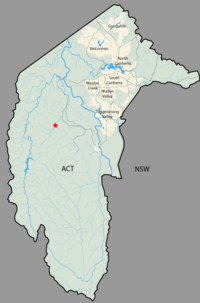This is an old revision of this page, as edited by Hoffmanj (talk | contribs) at 07:45, 20 July 2013 (Recent controversies topic added.). The present address (URL) is a permanent link to this revision, which may differ significantly from the current revision.
Revision as of 07:45, 20 July 2013 by Hoffmanj (talk | contribs) (Recent controversies topic added.)(diff) ← Previous revision | Latest revision (diff) | Newer revision → (diff)


The Canberra Deep Space Communication Complex (CDSCC) is a ground station that is located in Australia at Tidbinbilla in the Paddys River (a tributory of the Cotter River) valley, about 20 km from Canberra in the Australian Capital Territory. The complex is part of the Deep Space Network run by NASA's Jet Propulsion Laboratory (JPL). It is commonly referred to as the Tidbinbilla Deep Space Tracking Station and was officially opened on 19 March 1965 by the then Prime Minister of Australia Sir Robert Menzies.
The station is separated from Canberra by the Murrumbidgee River, but most notably by the Coolamon Ridge and Urambi Hills, but mainly by Bullen Range, that help shield the city's radio frequency (RF) noise from the dishes. Located nearby is the Tidbinbilla Nature Reserve.
The CSIRO manages most of NASA's activities in Australia.
In February 2010 CSIRO took over direct management of the site with the establishment of CASS (CSIRO Astronomy and Space Science). Previous to this CDSCC had been managed by external sub-contractor organisations, such as Raytheon Australia from 2003-2010.
The complex is one of just three in the world. The other two are the Madrid Deep Space Communication Complex located in Spain and the Goldstone Deep Space Communications Complex in the United States.
History

During the mid 1960s NASA built three tracking stations in the Australian Capital Territory.
- The Tidbinbilla Tracking Station (now known as CDSCC) was opened in 1965 and is the only NASA tracking station in Australia still in operation. During the Apollo program, Tidbinbilla was used for tracking the Apollo Lunar Module.
- The Orroral Valley Tracking Station (35°37′43″S 148°57′20.8″E / 35.62861°S 148.955778°E / -35.62861; 148.955778) was opened in May 1965 in what is now part of Namadgi National Park. Its role was orbiting satellite support, although it also supported the Apollo-Soyuz Test Project in 1975. It was closed in 1985.
- Honeysuckle Creek Tracking Station (35°35′1″S 148°58′36″E / 35.58361°S 148.97667°E / -35.58361; 148.97667 (Honeysuckle Creek)) opened in 1967 and was built primarily to support the Apollo moon missions, mainly communications with the Apollo Command Module. After the cancellation of the Apollo Project the station supported Skylab until its re-entry in 1979 when the station joined the Deep Space Network in support of the Viking and Voyager projects. 1981 saw the closure of the station and its 26 m antenna was moved to CDSCC to become known as Deep Space Station 46. After the antenna was removed the rest of the facility was dismantled and knocked down. Its foundation, access road and parking area are all that remains of the facility
Receivers

As of mid 2010 the Station has three large antennas in use. The CDSCC also uses the Parkes radio telescope in central New South Wales at busy times to receive data from spacecraft. There are plans to build up to three additional 34 m beam waveguide antennas by 2015. The first of these will be DSS-35 with preliminary construction having begun in July 2010.
- DSS-34 is a 34 m beam waveguide antenna, which uses a system of radio frequency mirrors to place the receiving and transmitting hardware underground rather than on top of the dish. It is the most recent antenna at CDSCC, being built in 1997.
- DSS-43 is a 70 m dish originally constructed as a 64 m in 1973 and enlarged in 1987. It is the largest steerable parabolic antenna in the Southern Hemisphere.
- DSS-45 is a 34 m dish built in 1986.
- DSS-46 is a 26 m dish. It was moved in 1984 from Honeysuckle Creek, where it was built in 1967. It was decommissioned in late 2009. In May 2010 the AIAA (American Institute of Aeronautics and Astronautics) declared the antenna a Historical Aerospace Site.
- DSS-49 is the designation of the 64 m dish at Parkes.
The station's collimation tower is located approximately 3 km to the north-west, on Black Hill.
Recent controversies
Sacked over a Big Mac
Jack Hoffman a NASA Deep Space Network electronics technician who was a long term CDSCC employee was mobbed and bullied out of his employment in July 2012 by the CDSCC HR Manager Ms. Linda Francis and the CDSCC Director Dr. Ed Kruzins.The justification that Dr. Ed Kruzins gave for the behavior of CDSCC senior management is that Jack Hoffman had bought a Big Mac meal on the way home on Friday 25th May 2012. Dr. Ed Kruzins had spent $18K of tax payer's money to conduct an investigation. Dr. Ed Kruzins demonstrated his incompetence by initiating an investigation without having the funds. The investigation was conducted by Peter Grills from Quality Management Solutions. Peter Grills had concluded in his 60 page report
See also
References
- "Antenna Construction - page 8" (PDF). NASA. Retrieved 18 July 2010.
- "AustraliaHistoricalSite" (PDF). AIAA. Retrieved 18 July 2010.
- Sacked over a Big Mac
- Ms. Linda Francis
- Dr Ed Kruzins
- Dr. Ed Kruzins is going to sack Jack Hoffman over a Big Mac meal.
- $18K Invoice for CDSCC investigation.
- CSIRO management squabbling about how they are going to pay for an investigation at CDSCC.
- Peter Grills - Quality Management Solutions
- Quality Management Solutions (QMS)
- Peter Grills Investigation Part No.1 20MB PDF
- Official CDSCC Webpage
- Official CSIRO pages
- Tidbinbilla Tracking Station tribute site
- Honeysuckle Creek tribute site
External links
35°24′05″S 148°58′54″E / 35.40139°S 148.98167°E / -35.40139; 148.98167
Categories: